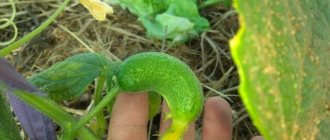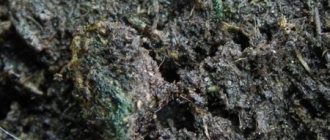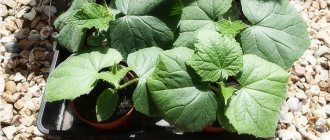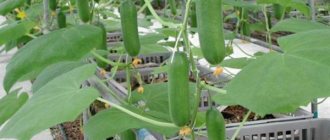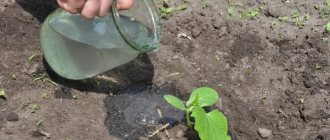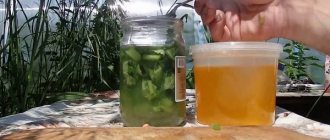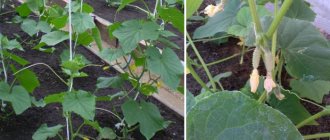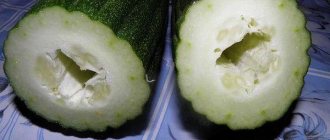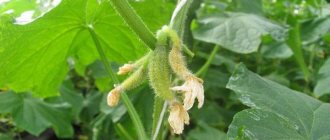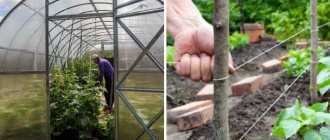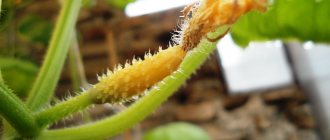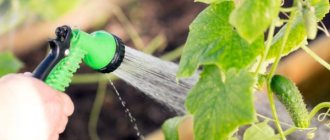Why do cucumbers grow with crochets?
There are several reasons. Either one of them or their combination leads to the appearance of hook-shaped fruits on cucumber bushes. The most common reasons that cucumbers grow crooked are lack of fertilizer, insufficient light and low temperature.
Fertilizer shortage
During the growing season, cucumbers are fed with nitrogen-containing fertilizers, as they promote the rapid growth of the green mass of the bush. But nitrogen leaches potassium from the soil, which is so important for the formation and proper growth of fruits.
Important! It is the lack of potassium in the soil that most often causes cucumbers to become deformed.
With an excess of nitrogen and at the same time a lack of potassium and phosphorus in the soil, during flowering and fruiting, the ovaries of the plants fall off and the greens do not ripen.
Insufficient lighting
Cucumber is a light-loving plant. Ovaries on it are formed throughout the bush, including on the lower lashes. The overgrown green mass blocks the access of sunlight to some ovaries, which leads to their falling off or deformation of the fruits.
If, in pursuit of a bountiful harvest, you have planted the plants too densely, do not be surprised at the hooked fruits, since the shadow from neighboring plants will also not let the sun's rays through to the cucumbers.
It can be useful:
How to deal with aphids on cucumbers in a greenhouse
How dangerous are black aphids on cucumbers?
How to get rid of whiteflies in a greenhouse on cucumbers
Low temperature
Cucumbers grow comfortably at an air temperature of 20–26 °C . If it rises higher, the fruits turn yellow and wither. At temperatures below 20 °C, cucumbers become deformed or stop growing altogether.
The greatest danger from incorrect temperature conditions is in the last phase of the cucumber flowering period - immediately before the start of fruiting. Errors at this stage can lead not only to crooked fruits, but also to the fall of the ovaries, that is, to a significant reduction in the yield.
Watering method
Most often, cucumbers curl due to improper watering.
There are several incorrect watering methods that every summer resident should avoid when growing cucumbers in a greenhouse:
- Watering with cold water causes deformation of the fruit. The greenhouse maintains relatively stable soil and air temperatures, which creates a favorable microclimate for the growth of a healthy plant. If cold water regularly gets into the soil, the roots of the plant crop become cold, the plant begins to redistribute all accumulated resources to neutralize the resulting damage, as a result, the fruits turn yellow and curl.
- Insufficient water used for irrigation leads to moisture deficiency. Cucumbers are plants that are very sensitive to soil moisture. During periods of drought, they begin to expend a minimal amount of resources to form fruits, which as a result curl and decrease in size.
- Excess moisture is also detrimental to cucumbers. In this case, crooked cucumbers in the greenhouse appear due to the formation of rot on the roots of the plant. Also, the plant crop loses the ability to fully extract the necessary substances from the soil, since they are washed out by large amounts of water.
If a summer resident does not know why cucumbers curl, the first thing to do is pay attention to watering the plant. If a sufficient amount of moisture is introduced into the soil, corresponding to the characteristics of the microclimate that has developed in the greenhouse, and the shape of the cucumbers continues to resemble a hook, then it is necessary to look for other factors that cause such a pathology.
Other reasons
If you find hooked fruits on cucumber bushes , although all the reasons listed above are excluded, check whether you are harvesting on time and whether you are watering the plants correctly. If you do this correctly and on time, the reason may be a violation of the rules of the neighborhood or the characteristics of the chosen variety of cucumbers.
Late harvest
The cucumber bush spends a huge amount of energy and nutrients on ripening the fruits . If the fruit is overripe and hangs for too long, the plant does not have enough strength to form new ovaries and normal ripening of new cucumbers.
Therefore, if you pick cucumbers rarely (less than once every two days), and especially at the end of the season, you will get crooked and small fruits on the cucumber bushes. The harvest will be several times smaller in quantity than it could have been if harvested in a timely manner.
Mistakes when watering
Watering is an important point when growing any plant, especially cucumber, because its fruits are 95% water. When watering cucumbers, you can make several mistakes that will lead to deformation of the fruit :
- Cold water. Watering with cold and ice water stresses the roots of the plant, which leads to the appearance of empty flowers and deformed fruits.
- Lack of moisture. During drought, cucumbers wilt, so water is essential for growth and fruiting. During the flowering period, gardeners advise limiting watering the plant to produce female flowers. And if there is a lack of moisture during the fruiting period, the cucumbers appear small and uneven.
- Excess moisture . If there is excess moisture, microelements are washed out of the soil and do not reach the fruits, which means that mature, even and large cucumbers will not grow on such bushes. In addition, excess water will lead to root rot and death of the plant.
Violating Neighborhood Rules
Oddly enough, the appearance of beautiful, even, healthy fruits depends on the plants located next to the cucumbers. Cucumber varieties of different types of pollination should not be placed side by side. If self-pollinating plants and those that require insects for pollination are not isolated from each other, the fruits will be deformed.
Lack of microelements in the soil
If the leaves of cucumbers turn yellow, what should you do? What to feed? Read our article HERE.
In order to obtain high yields, plants need sufficient nutrients. At the same time, cucumbers do not require an abundant supply of macro- and microelements - plants are not able to absorb everything at once. Cucumber bushes need fractional nutrition in small doses. In general, per season, in order to get up to 30 kg of fruit from 1 bush, about 25 g of nitrogen, 15 g of phosphorus, 60 g of potassium, 20 g of calcium, 5 g of magnesium are required per plant.
Per 1 kg of vegetables, 2.64 g of nitrogen, 6.6 g of potassium, 1.55 g of phosphorus, 0.57 g of magnesium, 2.19 g of calcium are removed from the soil. Cucumber absorbs nutrients gradually, maximum consumption occurs during the period of active fruiting. A lack of minerals inevitably leads to slower growth, shedding of ovaries, deformation of fruits, and death of plants. Therefore, feeding plants must not only be timely, but also done in a form accessible to plants.
Nitrogen
A lack of nitrogen can be determined without carrying out the necessary laboratory tests by the fact that plant growth is slow, the vines become thinner and woodier as they grow, the leaf blades do not increase in size, there are few new side shoots, the ovaries turn yellow and crumble, and the flowers dry out. The greens of cucumbers experiencing nitrogen starvation have pointed ends and thickenings in the area of the stalks and do not elongate. The leaves located in the root zone of the stem begin to turn yellow first, followed by yellowing of younger leaves.
This vegetable crop has average requirements for nitrogen content in the soil. Before planting seeds or seedlings of cucumbers, nitrogen is added to the soil at the rate of 20 g of ammonium nitrate per 1 m² of beds. If plants do not absorb nitrogen well, there may be several reasons. First of all, this is increased soil acidity. The second reason for poor nitrogen absorption is low air temperatures and, as a consequence, cold soils. In this case, nitrate nitrogen (sodium nitrate) should be used as fertilizing; fertilizing is carried out after the soil has warmed up to +15°C. On neutral or alkaline soils, nitrogen will be available to cucumbers in the form of ammonium nitrate.
Read about ammonia as a fertilizer in our article.
Potassium
With the onset of fruiting, in the flowering and fruit set phases, plants need phosphorus. When fruits gain weight, potassium comes first. Without sufficient potassium content in the fruit, cucumbers will not be crispy and sweet. Taste qualities will not correspond to the promises of breeders. Potassium is responsible for transporting nutrients from the soil to leaves and fruits. Without it, plant growth during the fruiting period is impossible. Potassium makes cucumber bushes resistant to pests and diseases.
Leaf marginal burn: potassium deficiency
Potassium deficiency is determined by the appearance of old leaves. They are characterized by a marginal burn. The edges of the still green leaves begin to dry out. Parts of their leaf blades turn yellow, the bleaching gradually spreads towards the central part of the leaves and is located between the main leaf veins. After a few days, the entire leaf turns yellow with green veins, and necrotic spots form along the edges of the leaves. With severe potassium deficiency, the leaves become wrinkled. The fruits take the shape of a light bulb, pear or hook.
To increase potassium in the soil, ash solutions, potassium sulfate or phosphate, and potassium magnesium are used. For fertilizing, prepare a composition of 25-30 g of potassium salt and 10 liters of water, potassium sulfate is added to the root zone in dry form at the rate of 50 g per 1 m2. At least 5 days should pass between watering the plants with liquid fertilizers and applying dry granules. Ash solutions are prepared at the rate of 0.5 liters of ash per 10 liters of water. First, make an ash extract - dilute the ash in a small amount of hot water and let the mixture brew, and then add the rest of the water. Up to 1 liter of ash fertilizer is used for each cucumber bush.
Feeding with iodine is an effective way to rehabilitate sick and weakened plants. Read about this in our article.
How and when to feed correctly
Fertilizers are applied to the root area of plants on the soil surface in liquid form. The total amount of nutrients ranges from 40 to 70 g per 1 m². The concentration of minerals in the solution should not exceed 0.7%. Before applying fertilizers, the soil must be shed with warm, settled water.
Root feeding alternates with leaf feeding. Spraying of mineral substances is carried out early in the morning, during the day - only in cloudy weather or in the evening. Foliar feeding helps plants quickly absorb the necessary elements, but cannot replace the addition of minerals to the soil. The main nutrition occurs through the root system. Fertilizing is carried out with warm solutions.
Fitosporin is a super remedy for proper development! How to use and when. Read our article HERE
Most often, it is impossible to determine exactly what element cucumbers lack. Signs of a lack of elements are very similar. Therefore, for fertilizing, prefabricated compositions of basic nutrients are used. Root feeding is carried out with solutions in 10 liters of water: 15 g of urea, 15 g of potassium, 50 g of superphosphate; 10 g nitrogen, 10 g potassium, 20 g superphosphate. For foliar spraying on the leaf, prepare a mixture of 5 g of nitrogen, 10 g of potassium, 15 g of superphosphate, 10 l of water.
How to feed: video
A problem occurs in the greenhouse
Why do crooked cucumbers grow in a greenhouse? Growing cucumbers in a greenhouse can affect the fruiting of plants both positively and negatively. On the one hand, it is easier to maintain and regulate the conditions in which a crop grows in a greenhouse than in open ground. On the other hand, an inexperienced gardener can easily make a mistake, which will lead to improper development of fruits in the greenhouse.
In a greenhouse, it is more difficult to isolate plants of differently pollinated varieties from each other and to comply with the rules of proximity. And for proper growth of insect-pollinated cucumbers in a greenhouse, you have to resort to artificial pollination.
Crochet cucumbers in open ground
When cucumbers grow in an open garden bed, it is more difficult for the gardener to influence temperature conditions and watering (for example, during abnormal amounts of precipitation).
It’s easier to follow neighborhood rules in open ground by planting bushes of differently pollinated varieties in different places. At the same time, protecting self-pollinating cucumbers from insects is much more difficult than in a greenhouse.
Tips from Mister Summer Resident
It is better to foresee various unfavorable situations before planting seedlings in the ground, so that you do not have to correct the consequences later.
Important nuances that our portal https://mrdachnik.com advises you to pay attention to:
- Do not neglect the rules of crop rotation. Do not plant cucumbers after zucchini, pumpkin, and dill.
- Be careful when choosing a variety. Plant self-pollinating species in the greenhouse, and those that need insects in open ground.
- Do not thicken the plantings, leave enough space between plants.
- Either keep water for irrigation in a container in the sun or add boiling water to it. It is better to apply foliar fertilizers in cloudy, rainy weather.
- Use green manure plants to restore soil balance.
What to do
If you notice twisted fruits on cucumber bushes, first determine the reasons for their appearance. Some of them can be easily fixed, others are much more difficult to deal with :
- Take action immediately to avoid ending up with a whole crop of hooks. During the flowering and fruiting period, remove nitrogen-containing fertilizers from the fertilizing, add potassium and phosphorus.
- If the bushes are planted too close and shade the sunlight, and it is no longer possible to plant them wider, cut off the excess leaves. If this does not help, you will have to sacrifice some plants.
- Remember that at air temperatures below 20 ° C, cucumbers slow down or stop growing altogether, and the fruits are formed with a hook. Try to regulate the temperature in the greenhouse to the optimal temperature for cucumbers (20–26 °C), and in open ground, when it’s cold, stop watering the plants.
- It is necessary to harvest cucumbers every 2-3 days, at least. Experienced gardeners advise picking fruits slightly unripe. So the taste will be at its best, and nothing will harm the plant and future fruits.
- The ideal water for watering cucumbers is soft, rainwater, and room temperature. Carefully monitor watering of plants. If you find any violations, correct them. In hot weather and drought, water the bushes generously twice a day during the fruiting period. Do not overdo it with watering, so as not to spoil or completely destroy the crop.
- If you violate the rules of the neighborhood, you can artificially protect different varieties of cucumbers from each other, and some from insects. Block insect access to the greenhouse to save self-pollinating plants, and use artificial pollination for insect-pollinated plants. In open ground, it is better to cover self-pollinating bushes with gauze during the flowering period.
What to feed
To get a bountiful, healthy and beautiful harvest, plantings should be fertilized with mullein, during flowering - with chicken droppings, and during fruiting - with ash.
Important! During the flowering and fruiting period, exclude nitrogen from the fertilizer complex and use potassium and phosphorus.
Fertilizing is a complex process when growing cucumbers . Both a deficiency and an excess of useful elements in the soil leads to a poor harvest. The main elements for cucumbers are potassium, phosphorus, nitrogen, iron and copper.
What needs to be done to prevent the formation of crochet cucumbers (prevention)
So, what should you do to get an even and beautiful harvest of cucumbers? Please note and implement the following recommendations:
- Fertilize plants with potassium. Before planting seedlings in the greenhouse, add potash fertilizers to the soil.
- Remove ripe fruits from the bush in a timely manner to stimulate active fruiting.
- Organize watering correctly, taking into account the temperature of the soil and air and the degree of illumination.
- Maintain a constant temperature in the greenhouse, avoiding sudden changes. Another option is to select varieties that are not so sensitive to adverse conditions.
- Observe the correct planting pattern, pinch out side shoots in time and carry out pinching.
- Take preventive measures against pests in a timely manner.
Prevention measures
How to prevent fruits from starting to curl? It is necessary to comply with all conditions and rules for caring for cucumbers from the very beginning . Then you won’t have to panic and take measures that don’t always lead to the expected result.
An important point in prevention is crop rotation . First, cucumbers are not planted in the same soil for four years. Secondly, after crops such as pumpkin, zucchini and dill, there are practically no macro- and micronutrients left in the soil. This worsens the fruiting process and the cucumbers become deformed.
Special attention should be paid to the choice of variety . According to statistics, the fruits of the following cucumbers curl the least: Octopus, Twixie, Othello, Paratunka. For a greenhouse, choose self-pollinating varieties; for open ground, choose insect-pollinated varieties.
When planting, pay attention to two points : proximity and distance between bushes. According to the rules, self-pollinating and insect-pollinated varieties of cucumbers must be planted as far as possible from each other (preferably at different ends of the greenhouse or plot).
Important! When planting, the distance between bushes growing nearby should be at least 10–20 cm so that they do not interfere with the penetration of sunlight.
Lack of light and heat
Cucumbers often become distorted due to lack of heat and lighting. In order for cucumber fruits to grow evenly, they need to create an optimal ambient temperature for growth, which is set between 23–26 degrees Celsius. This temperature regime must be observed with special care during the final flowering phase. When the temperature in the greenhouse exceeds these values, the cucumber fruits become withered and begin to curl from drying out. If the temperature is lower, the plant quickly becomes ill and begins to produce dense but bent vegetables.
See also
Growing, characteristics and description of bush cucumber varieties for open groundRead
A lack of light can be caused by cloudy weather, thickening, or improper greenhouse design. Lack of lighting caused by any of the above reasons negatively affects vegetative processes and photosynthesis. As a result, the cucumber fruits bend. If cucumbers grow strongly in a greenhouse, they need to be pinched, bushes pinched, and foliage thinned. Such procedures will avoid thickening of plantings and lack of lighting.
Advice from experienced gardeners
Every gardener has at least once encountered hook cucumbers in the garden or in the greenhouse. Advice from experienced farmers will help you grow healthy, even and juicy fruits :
- Maintain crop rotation. The best predecessor crops for cucumbers are tomatoes, peppers, carrots, cabbage, and onions.
- For balanced moisture, mulch the soil with straw or peat after each watering.
- Stop watering when the air temperature is below 15 °C.
- Pick cucumbers 4–6 cm long from the vine.
- Once every two weeks, feed the cucumbers with an infusion of wood ash and potassium fertilizers.
- In late summer, use covered beds and greenhouses to avoid cold temperatures.
- Be sure to warm up water for irrigation in the sun, and in bad weather, boil and dilute with cold water.
- Carefully treat the greenhouse at the end of the season, disinfect it from diseases and pests that may have remained in the soil or located on the internal surfaces of the greenhouse.
Important! Water and spray cucumber bushes early in the morning (before 10:00) or in the evening (after 18:00). In hot weather, watering during the day may cause the plant to get sunburned.
How to grow fruits of the correct shape?
To make cucumbers look like themselves, follow simple rules:
- watering: only warm water, and only at temperatures above 20 degrees;
- lighting: minimum direct sunlight. During the daytime, plants should be protected from ultraviolet radiation;
- nutrition: all essential substances must be in harmony. Plants that are deficient in one or another element bear fruit of poor quality.
As for pest control, try to use gentle, natural-based products. Otherwise, the fruits will be no different from those that are overfed with chemicals in large fields.
Violation of agricultural technology
One of the main reasons why cucumbers are deformed by a hook and become pear-shaped is a violation of the rules of agricultural technology for cultivating cucumber crops.
Crop rotation
Planted after pumpkin crops, strawberries, eggplants and tomatoes, which take all the potassium from the soil, cucumbers grow irregularly shaped: they become pear-shaped or hooked.
Recommendations
In conditions of limited acreage, the fertility of the soil can be replenished by planting green manure cucumbers before late planting. Oats are considered to be the most potassium-rich green fertilizer of all green manures.
Unsuitable varieties
The cause of fruit deformation is often an incorrectly selected variety.
Cucumbers become bent, become round, or curl if the variety is chosen incorrectly: it does not fit the description for a particular season. Thus, by the end of the summer, light-loving and heat-loving varieties will certainly begin to react to a decrease in ambient temperature and a decrease in daylight hours, which is why they will begin to change their shape.
Recommendations
Early varieties of cucumbers that love light and warmth need to be planted a little earlier and harvested before the end of August.
In terms of the percentage of potential formation of ugly vegetables, the hybrids Twixie, Paratunk and Othello are least likely to appear. By the end of August, from Patty, Champion and Thumb, in 100% of cases you will be able to get twisted fruits with a thin stalk or an ugly shape.
Wrong neighborhood
Pollinated and parthenocarpic varieties of cucumbers should not be planted next to each other, especially in a closed greenhouse. Parthenocarpic varieties are intended for growing mainly indoors, since hybrids form an ovary without pollination. But when their flowers in the vicinity of the inflorescences of classical varieties attract pollinating insects, in most cases this leads to deformation of the fruits and the growth of cucumbers of irregular shape.
Recommendations
Neighboring varieties, while saving sown area, are isolated from each other with non-woven covering material. Also, when growing hybrid varieties, you should not often open the windows in the greenhouse, so as not to attract insects and eliminate the risk of cross-pollination of parthenocarpic varieties with other varieties.
